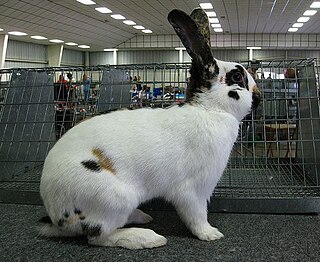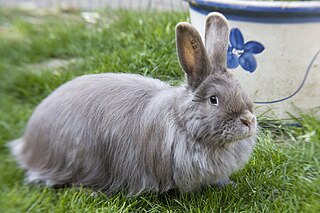
The Californian, also known as the California White, is a breed of domestic rabbit initially developed for the fur and meat industries by George S. West of Lynwood, California, starting in 1923. West maintained a herd of 300 genetically pure New Zealand Whites, which he began crossing with Standard Chinchilla rabbits for their dense coat and Himalayan rabbits. This new breed, named after the state of its origin, was first shown in 1928, and a standard was accepted by the American Rabbit Breeders Association (ARBA) in 1939.

The Dutch rabbit, historically known as Hollander or Brabander, is a breed of domestic rabbit. It is easily identifiable by its characteristic color pattern and was once the most popular of all rabbit breeds. However, after dwarf rabbits were developed, the popularity of the Dutch rabbit declined. Nevertheless, the Dutch rabbit remains one of the top ten most popular breeds worldwide.

The Mini Lop is a breed of domestic rabbit that is recognized by the American Rabbit Breeders Association (ARBA). It is different from the Miniature Lop breed that is recognized by the British Rabbit Council (BRC). The Mini Lop [US] and the Miniature Lop [UK] are different from the Dwarf Lop breed that is recognized by the BRC. The Mini Lop is similar to several other small rabbit breeds, such as the Dwarf rabbit.

The Holland Lop is a breed of lop-eared rabbit that was recognized by the American Rabbit Breeders Association (ARBA) in 1979. The Holland Lop, with a maximum weight of 1.8 kg (4 lb), is one of the smallest lop-eared breeds.

Mini Rex is a breed of domestic rabbit that was created in 1984 in Florida by the late Monna Berryhill of Texas. The Rex mutation, derived in France in the 19th century, is recessive and causes the hair to protrude outwards from the body, instead of lying flat, and the guard hairs to be shortened to the length of the undercoat, or a bit longer.

The French Lop is a breed of domestic rabbit developed in France in the 19th century from the selective breeding of English Lop and Flemish Giant stock. The French Lop resembles the English Lop, but the French Lop is heavier in stature and does not have the exaggerated ear length of the English Lop. Weighing approximately 4.98 kg to 5.21 kg, it has an average lifespan of five to seven years. The French Lop is currently recognized by the American Rabbit Breeders Association (ARBA) and by the British Rabbit Council (BRC).

Lionhead is a breed of domestic rabbit recognized by the British Rabbit Council (BRC) and by the American Rabbit Breeders Association (ARBA). The Lionhead rabbit has a wool mane encircling the head, reminiscent of a male lion as its name implies. Other Lionhead characteristics include a high head mount, compact upright body type, short well-furred 2- to 3+1⁄2-inch ears, and a weight of 2.5 to 3.75 pounds.

The term rex rabbit refers informally to one of at least eight breeds of domestic rabbit. One such breed is the Rex, which is recognized by the American Rabbit Breeders Association (ARBA) and by the British Rabbit Council (BRC). Other modern-day rex rabbit breeds are listed below. Care must be taken to distinguish the rex rabbit breeds from the three types of rex rabbit fur for which they are known.

The Argenté rabbit is one of the oldest breeds of French show rabbits. The British Rabbit Council (BRC) recognises six varieties: Argenté Bleu, Argenté Brun, Argenté Crème, Argenté de Champagne, Argenté Noir, and Argenté St Hubert. The American Rabbit Breeders Association (ARBA) recognises the Champagne d'Argent, the Crème d'Argent and the Argenté Brun. A rare variety, the Argenté Clair, is not currently recognised by either the BRC or ARBA.

The Tri-Colour Dutch is a breed of domestic rabbit created in the Netherlands by crossing tortoiseshell Dutch rabbits with Harlequin rabbits. The Tri-Colour Dutch breed is recognized by the British Rabbit Council but not by the American Rabbit Breeders Association. The coat of the Tri-Colour Dutch is white in the same places as a Dutch rabbit, but the coloured portions of the coat are a mix of orange with either black, blue or chocolate.

The New Zealand is a breed of rabbit, which despite the name, is American in origin. The breed originated in California, possibly from rabbits imported from New Zealand. New Zealand rabbits are available in five colors recognized by the American Rabbit Breeders' Association (ARBA): white, red, black, blue, and broken. Crossbreeding can result in many other variations, such as gold tipped steel and chestnut agouti. They average 10–12 lb (4.5–5.4 kg) with the does being slightly larger than the bucks. New Zealands are bred for meat, pelts, show, and laboratory uses, being the most commonly used breed of rabbit both for testing and meat production. They are also bred as pet rabbits but mostly breed for meat.

Miniature Lop is a breed of domestic rabbit recognised by the British Rabbit Council (BRC). Confusion arises because, in the UK, the Miniature Lop is often commonly called the Mini Lop. It is, however, a different breed from the Mini Lop that is recognized by the American Rabbit Breeders Association (ARBA). The BRC-recognized Miniature Lop is most similar to the ARBA-recognized Holland Lop. The Miniature Lop is also similar to several other small rabbit breeds.

The Rhinelander is a medium-sized breed of domestic rabbit that originated in Germany. Rhinelanders are known for their distinctive facial "butterfly markings", a spine marking, colored ears, cheek spots, eye circles and side markings of black with orange or of blue with fawn. The Rhinelander breed is recognized by the British Rabbit Council (BRC) and by the American Rabbit Breeders Association (ARBA).

The Harlequin is a colourful breed of rabbit originating from France. It is a breed based around the coloration and markings, rather than fur and body type. The ideal weight of a standard Harlequin is 6.5-9.5 lb (2–3 kg), with bucks (males) weighing 6.5-9 lb, and does (females) weighing 7-9.5 lb.
The Lilac rabbit is a dove-blue coloured breed of domestic rabbit. A uniform pink shade of dove is called for by the breed standard, with matching eyes. Lilacs are mid-sized, docile and hardy rabbits. Developed in Great Britain in the early 20th century, the breed spread to the United States in 1922. Population numbers remain low enough that it is currently listed by The Livestock Conservancy as a breed to watch. The Lilac breed is recognized by the British Rabbit Council (BRC) and the American Rabbit Breeders Association (ARBA).
The German Lop rabbit is a recognised breed by the BRC. It is a very chunky and cobby Lop rabbit.

The Podenco Valenciano, also known as the Xarnego Valenciano or Gos Coniller, is a warren hound originating in Valencian Community, Spain. It was officially recognized by the Real Sociedad Canina de España in 2017.

The Swiss Fox is a domesticated breed of rabbit originally bred for commercial use of their fur, but now kept mainly as pets. It is a recognised breed in the UK by the British Rabbit Council as a "Normal Fur" breed, however unrecognised by the American Rabbit Breeders Association making it a rare breed in the US.















